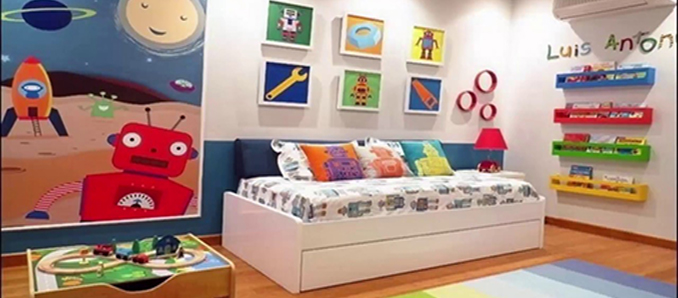 Are you tired of the look of your kid’s room? Perhaps you’re expecting a new child or moving into a new home and need to prepare a kids’ room? Whatever it is, decorating a room is not at all simple. Different rules and tricks apply to different rooms and sizes. While you might approach your kitchen or your bedroom with a more ‘adult’ and serious tone, a kid’s room requires a very specific child or teen room décor that you should master before you begin.
Are you tired of the look of your kid’s room? Perhaps you’re expecting a new child or moving into a new home and need to prepare a kids’ room? Whatever it is, decorating a room is not at all simple. Different rules and tricks apply to different rooms and sizes. While you might approach your kitchen or your bedroom with a more ‘adult’ and serious tone, a kid’s room requires a very specific child or teen room décor that you should master before you begin.
In this article, you’ll learn some very useful decorating tips for your child’s room. There are certain things you can do to make this easier for yourself, more affordable for the family’s budget, and more enjoyable for the child. The following 10 tips should help you design an amazing kid’s room for your home.
1. Wall Decals
Decals are an excellent and modern way to decorate the walls of your house. These are the perfect option for those who rent and aren’t allowed to paint the walls. Moreover, if your child is young, you might have troubles when he or she starts drawing on the actual wall paint. With wall decals, you can simply replace a part or change the entire room with a small investment. Installing wall decals s very easy once you get the hang of it.
With so many children wall decal options today, you can make many combinations. You might want to include your child in choosing the wall decals. This way, you’ll be sure that they like them and when they ‘grow out of it’, you’ll simply remove or replace them with something more teen-like.
2. Homework Area
Every parent wants his child to be a success at school and in life. If your child is old enough to do homework and study, you definitely want to create a great study area for them in their room. It’s a known fact that the environment can boost or kill the motivation of a student, which is why you should create an area for school work in your child’s room.
 The kid’s room should be arranged in non-aggressive colors that don’t distract the child and be well-lit for them to be able to do their homework. Surely, high-quality and assignment help is always an option when some of the homework turns out to be too complicated. But, for the rest of them, you need a cozy chair, well-lit study area, and a nice desk your child can study at.
The kid’s room should be arranged in non-aggressive colors that don’t distract the child and be well-lit for them to be able to do their homework. Surely, high-quality and assignment help is always an option when some of the homework turns out to be too complicated. But, for the rest of them, you need a cozy chair, well-lit study area, and a nice desk your child can study at.
1. Relax Zone
In addition to having a study zone, one of the best kids room ideas is to add a relax zone where the child can go to rewind and refuel. Add a beanbag or any other comfortable chair to the room and allow your child to daydream and relax.
2. Maximize Their Space
If space is small, try to maximize it by pushing things against the walls, placing the head of the bed in one of the corners, and remove the open space around the sleeping space. The latter applies to cases where your child is young and possibly afraid of things that might lurk under their bed.
1. Add Open Shelves
Children often do mess and most of the time, there’s nothing you can do about it. To make organization simpler for them and yourself, add many open shelves, baskets , and bins that will keep their many things contained. This makes for an easy access and even easier organization.
2. Bunk Beds
Small rooms with more than one kid have a simple and very popular solution – bunk beds. Children will love them and probably fight for the top bed, but you can always resolve this issue by setting a nice schedule that allows them to change shifts.

1. Divide and Conquer
Children who sleep together in one room often squabble or do the exact opposite – hang out too much. So, you’re looking at a lot of chatter after the lights go out and sleepy and nervous children the next day. To avoid all this from happening, don’t go for bunk beds. You can divide the beds with a curtain, a bookcase, a dresser, or a ceiling-mounted rod. They’ll still be together, but have some barrier between them to keep sleeping time an actual time to sleep.
2. Listen to the Child
Children have their own personality, even at the youngest age. Let them express this personality by including them in their room’s design. You don’t have to let them go wild and choose the most expensive things, but definitely include them in the purchase of the bedsheets, wall decals, and basically – their bedroom’s theme. Everyone deserves to take part in the decoration of the place where they spend most of their time.
3. Low-Level Closet
Remember that your children aren’t as tall as you are, at least not for the moment. Many parents fail to consider this and purchase regular closets. Then they end up having to reach things for them and the children constantly struggle with getting their things out. If your child has to climb a chair or a table to reach a hanger, you’re putting them at unnecessary risk.
Label the drawers, use shelves for the items, and basically bring the closet to your child’s level.
4. Have Some Fun
To make a room great for a child, you need to wake the child within. You won’t be able to create a comfortable kid’s room if you look at it as the rest of the rooms in your house. Use your imagination and have some fun with it. With some creativity and some fun, you can do great things with your kid’s room.
Conclusion
Is it time to decorate your child’s room? If it is, you should start right away. Think of a motif, discuss the theme with your child, and go shopping. There are plenty of things you can do to make your child’s room fun and comfortable to stay in. After all, this is the room where your child will be spending most of his time, which makes it very important to design it properly.
The kid’s room is the place where your child will sleep, rest, and study or write homework. With the tricks above, you can design it perfectly. But, don’t forget to consult your child and make sure that the room is something he’d love.
Author’s Bio:
Alvin Franklin is an educator and writer. He has his Master’s degree in teaching and a Ph.D. in children psychology. Based on his qualifications, Alvin has established a tremendous reputation for himself by performing research on students in his classes, as well as sharing his experiences and knowledge in numerous blogs and websites online.








